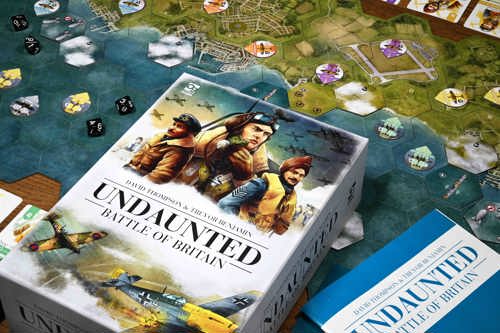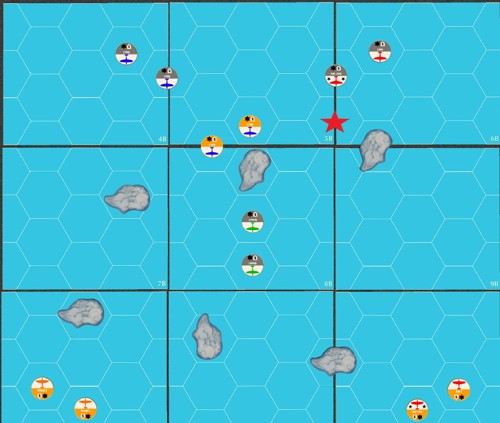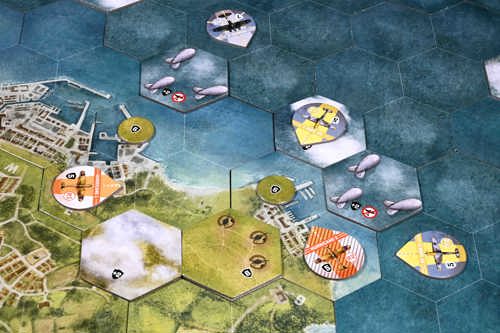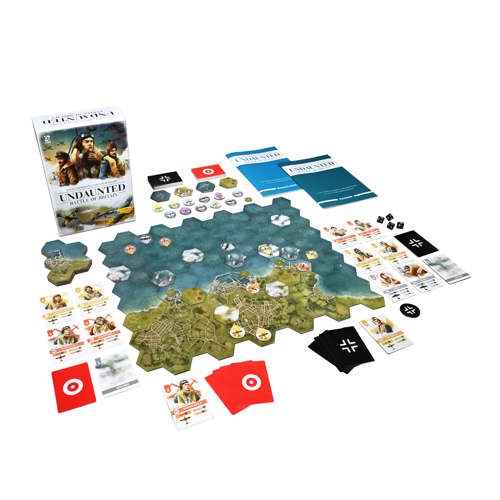
Undaunted is almost ready to take to the skies with the latest instalment, Battle of Britain. But before then, hear from co-designer David Thompson all about the design process behind the scenes of this exciting new direction for the series...
Undaunted: Battle of Britain is a standalone game in the Undaunted series, adapting the core gameplay of the previous games to recreate the dynamic dogfighting of aerial combat.
In Undaunted: Battle of Britain you lead RAF or Luftwaffe aircraft and battle over the skies of Britain in the most famous aerial battle in history. In the game you’ll experience dogfights and bombing runs, with British ships trying desperately to escape the Luftwaffe, antiaircraft guns aiding the RAF fighters, and much more.
This is the story of how Undaunted: Battle of Britain came to be…
Origin
The origin for Undaunted: Battle of Britain can be traced back to April 2021, when Trevor and I were finalizing the details of Undaunted: Stalingrad with Osprey. As we were putting the finishing touches on Stalingrad, we began discussing what the next game in the series would be. Nestled within a long email about Stalingrad was this sentence that Trevor and I had sent to Osprey:
“...or would you prefer to go with something totally crazy with a scale/scope change, like re-working the soldiers as planes and creating a Battle of Britain type game where you command a squadron of aircraft?”
Filip Hartelius was the lead developer at Osprey at the time, and replied to the email later that day, saying:
“For future games, on account that Normandy, North Africa, and Stalingrad will exist, I would love to do something a bit different, so Battle of Britain seems like a great fit.”
And so, Undaunted: Battle of Britain was born – or at least conceptualized! Osprey wanted it as a 2023 release, timed for either UK Games Expo (June) or GenCon (August). Trevor and I needed to complete the core gameplay concepts by June 2021, complete 80% of the design by December 2021, and hand over everything by March 2022.
The timeline meant that Trevor and I would have just under a year to complete the design for the game. While a year might seem like plenty of time, we were also juggling quite a few other projects, our day jobs, and family life. So we got started right away.
Research
We immediately started to compile research material. We hadn’t actually settled on the scale of the game yet, and our research would help us make that decision. Who were the players in this game? Did they control entire squadrons? And if so, what did each counter on the board represent? Each card?
We identified a TON of Osprey books that would help us out with the research stage (one of the obvious benefits of making a military-themed game with Osprey is their massive catalog of military history books). Osprey sent them over right away and Trevor and I pored over them, trying to identify the right time period, regional focus, and scale for our game.
Over the next couple weeks, Trevor and I met often, comparing our research and notes, chatting about what we felt would make for the most engaging game, while also leveraging the core Undaunted system. We knew the game had to feel like Undaunted, but we were also willing to push the system to the extreme.
Ultimately, for scale, we decided that each player would command about four to six aircraft in each scenario. The counters on the board would represent the aircraft, while the cards would represent the crew of the aircraft. This kept Undaunted at the personal scale, which felt right.
The Setting
Although the game is titled Undaunted: Battle of Britain, its scope is technically a bit broader. It begins in May 1940, during the Battle of France and the evacuation of Dunkirk. It includes “nuisance raids”, where the Luftwaffe conducted small scale attacks across the English Channel as early as June, and then of course the actual Battle of Britain, which began in late June. The final scenario in the game covers the Blitz, in which the Luftwaffe changed tactics and began the strategic bombing of cities.
The Design
In May, just a couple months after starting our work on Battle of Britain, Trevor and I reached out to Filip and Anthony Howgego at Osprey and let them know we were ready to show them the first prototype of the game.
This is an excerpt from that email:
“Gents, we’re ready to show you the core gameplay concept we’ve developed for Undaunted: Battle of Britain. The concept is that the players play elements of the RAF and Luftwaffe from Dunkirk through the Blitz. Each unit = 1 plane, so players are controlling about six aircraft each in a typical scenario. We’ve included a couple screenshots from the most recent test (RAF fighters trying to stop BF 110C’s bombing key targets, while they are defended by BF 109E/Fs).”
And here is one of those referenced screenshots, using prototype components in Tabletop Simulator.
Filip, Anthony, Trevor, and I met at the end of May, where we walked them through our prototype. Filip and Anthony liked the direction we were headed, so Trevor and I immediately went back to the design, began sketching out the general concepts for all the scenarios, and finalized our choices on which aircraft would be included in the game.
So What’s Different about Battle of Britain?
While Undaunted: Battle of Britain uses the same core gameplay concepts and play patterns as the rest of the Undaunted series, it is also the most different and unique of the family.
First, there is the obvious difference of the transition from offset squares to hexes for the board. Topographically the two are essentially identical. However, Undaunted: Battle of Britain uses facing for aircraft (that is, it matters what direction the aircraft counters are rotated), and that facing is easier to track with hexes. Similarly, unlike in other Undaunted titles, the aircraft in Undaunted: Battle of Britain can only attack in certain directions, which again, is easier to track with hexes.
Second (and this is closely related to the point above), planned movement is much more of a critical element of the game in Undaunted: Battle of Britain. Each plane has a Move rating, ranging from one to three spaces, which it can move in a single action. Accompanying that movement rating is a Maneuver rating. The Maneuver rating determines how many times you can rotate the plane counter during each action. So, for example, if you have a Spitfire that can Move 3 and Maneuver 3, you could move it up to three spaces and rotate it three times, all in one action. Each rotation must be broken up by movement of at least one space. Now compare that Move and Maneuver of the Spitfire to something like a Luftwaffe bomber that only has a Move and Maneuver rating of 1. But despite the superiority of the RAF fighters over the Luftwaffe bombers, the RAF will also have to deal with German fighters (and of course both sides will have to deal with obstacles such as barrage balloons and environmental conditions such as clouds). And one last note about movement and maneuvering in Undaunted: Battle of Britain: if you attack your opponent from the rear, you gain a significant bonus to the attack – something that should be exploited at all costs!
Third, in Undaunted: Battle of Britain we’ve moved away from the idea of scouting. In the other games in the series, when a scout moves to a new terrain tile, you place a scout token on the board and gain a Fog of War card. The Fog of War card represents the strain on command and control within the unit as the scout expands the area covered by your unit. That concept doesn’t really apply in aerial combat. Instead, we’ve introduced the idea of maintaining communications between aircraft. Each set of two fighters in the game are organized as a section. Those two fighters have a Section Comms card, which operates similarly to a Squad Leader card from Undaunted: Normandy and Stalingrad. You can use the Section Comms card to support the two fighters in the section (by adding new cards from those fighters, allowing them to take extra actions, etc). However, if you use the Section Comms card and the fighters are more than two spaces apart, you have to add a Discord card to your deck. Discord cards work just like Fog of War – that is, they are essentially a dead card in your deck. In this way, the game allows you to take important support actions with the Section Comms card if you want, but if the two fighters in a section are operating independently you will have to pay the price for the lack of cohesion.
In the end, playing Undaunted: Battle of Britain works similarly to other Undaunted titles, but it feels very different.
Development
Trevor and I completed our work on Undaunted: Battle of Britain at the end of August 2021, putting us well ahead of Osprey’s request to have the complete game design to them by March 2022. Trevor and I met with Osprey Games in early September to walk them through the design, including providing an overview of the scenarios and all the critical gameplay elements we added. (As an aside, during that same meeting, we brainstormed future titles in the Undaunted series - but that’s secret for now!)
At that point, we turned the design over to Filip and Anthony at Osprey Games. They put the game through its paces through the end of 2021 and beginning of 2022. Occasionally they would reach out about specific design intent, strategies, and clarifying questions for various scenarios. But other than minor tweaking, from a gameplay perspective nothing significantly changed between the design Trevor and I delivered and the final game. However, as always, the game benefited immensely from Osprey’s amazing attention to detail when it comes to delivering an amazing, top quality final product.
Art
Undaunted: Battle of Britain is gorgeously illustrated by the amazing Roland MacDonald. I say this for each Undaunted game in the series, but I really do believe that Undaunted: Battle of Britain is the most beautiful game in the series. It would have been very easy to lose the personal touch that the previous Undaunted titles have had in the shift to an aerial combat game. But the decision to keep the cards focused on the crew, and Roland’s gorgeous art, really helped keep the game feeling personal.
Here’s a comparison of what we used for our playtesting and Roland’s final work:
Release
When Undaunted: Battle of Britain is released on 13 June 2023, it will mark the end of an over two-year process to make the game a reality. From the very first email where Trevor and I pitched the idea of “something totally crazy”, to the published version of the game that includes Roland's evocative art, the creative process for Undaunted: Battle of Britain has been fresh and exciting for all of us. I think I can safely speak for Trevor, Roland, Filip, Anthony, and everyone at Osprey Games when I say that we truly hope that folks enjoy playing Undaunted: Battle of Britain as much as we enjoyed making it.
Undaunted: Battle of Britain is available 15th June in the UK and 13th June in the US.
And play it for the first time at UK Games Expo this weekend, 2nd-4th June!

















Comments
You must be logged in to comment on this post. Click here to log in.
Submit your comment